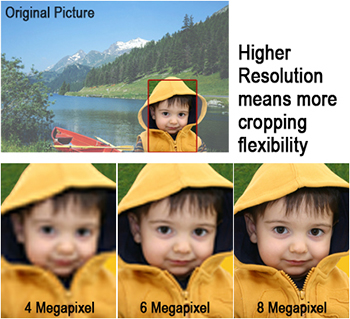Choosing a Digital Camera

Digital
cameras are one of the most popular commodities on the market and
it seems that everyone wants one these days. Whether you are a student needing
a digital camera for a photography class, or a photographer wanting to one-up
the competition, there is a digital camera out there for you. When choosing
a digital camera, there are several considerations to keep in mind: resolution,
zoom, size, on-camera features, batteries, brand, services and warranties provided. Read below for more on these features.
Resolution

When choosing a digital camera, picture quality is a major issue. Resolution is just one of the aspects that affects picture quality. Resolution is determined by the number of megapixels, or the number of millions of dots of color an image is made of.
Many people assume that the higher number of megapixels, the better the camera. The larger number of megapixels will allow you to blow up images to a larger size while maintaining quality; however, the images must be enlarged before you will see a real difference.
Ask your Camcor Representative how many megapixels you need for your needs.
Zoom
 In addition to resolution, zoom is also an important aspect of choosing
a digital camera. Zoom in general refers to the process of making subjects
appear closer. Three types of zoom advertised by manufactures are optical
zoom, digital zoom and total zoom.
In addition to resolution, zoom is also an important aspect of choosing
a digital camera. Zoom in general refers to the process of making subjects
appear closer. Three types of zoom advertised by manufactures are optical
zoom, digital zoom and total zoom.
- Optical Zoom: Optical zoom uses physical movement within the body of the lens to make things appear closer. No degradation of quality.
- Digital Zoom: Digital zoom is like hitting enlarge on a copy machine. It does not add anything to the picture and there is a loss of quality.
- Total Zoom: Many manufacturers advertise a total zoom, which is the combination of digital and optical zoom.
On-Camera Features

On-camera features are those extra little bells and whistles that make camera A different from camera B. Some may make a great difference to you when choosing a digital camera. Read below for more.
- Red-Eye Reduction: This feature is a series of pre-flashes that make the pupil smaller and provide less of a reflective surface for light to bounce off-of. While it reduces red-eye, it doesn’t necessarily remove it.
- Optical Image Stabilization: Image stabilization, also called vibration reduction is a mechanism that involves movement of lens and/or the CCD chip the minimize blurriness due to motion.
- Digital Image Stabilization: Digital image stabilization is marketed by many manufacturers as a way to capture images in low-light without the use of a flash. It is not true image stabilization as it involves no movement of the lens or the CCD chip.
- Face Detection: Face detection is a feature on newer cameras in which the camera detects faces and meters exposures around those focus points.
- Scene Modes: Scene modes allow you to change the camera settings to take a specific type of picture. For example, a portrait mode intentionally blurs the background while leaving the subject in focus, drawing the viewer’s attention to it.
Other Considerations

When choosing a digital camera, there are other considerations and questions to ask your Camcor Representative. These include:
- Size: You have a wide range of selection when it comes to camera size, from credit card size and up. Do remember that generally speaking the smaller the camera the smaller the zoom lens.
- Service and Warranties: Most cameras will either come with a 90-day or 1-year limited warranty. To protect your investment, extended warranties are available that can give you up to 3-years of protection from manufacturer defects.
Camcor Links

|
|

|

|
![]()
Contents of all material on website ©2025 Camcor, Inc. All Rights Reserved.